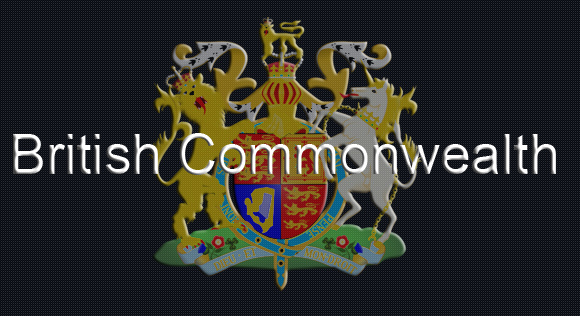
AAustralia

AAustralia
Australia’s military police originated with the creation of the Australian Imperial Force (AIF) Police Corps formed in Palestine in 1916. In February 1917, its name change to the “ANZAC Provost Corps” and then on 1 January 1918 to the “Australian Provost Corps”. This was then disbanded in 1920.From then until 1938 there was no permanent Military Police for in the Australian army.
During this period individual garrison areas formed their own RP or Regimental Police to carry out any required Provost functions.
In 1938 the military police was reformed as the Australian Army Provost Corps and served as such through World War Two up until 1948 when its name was changed to the Royal Australian Army Provost Corps having, like the British CMP, gained the “Royal” prefix as a reward for its performance during the war.
In 1948 a new badge was created showing crossed swords within a laurel wreath topped by the King’s Crown. Prior to this date, Australian MPs did not have their own cap badge but were identified by the wear of a white belt with the only special insignia to identify their role being an MP armband.
Some sources refer to the use of a shoulder type title with the letters MP being used both as a shoulder title and as a cap badge on the slouch hat (analogous to the use of the MFP / MMP titles in the same manner in the British army) but period photos cast doubt on this and tend to show the MP armband as the only specific insignia. Cap and collar badges were those of the original parent unit from which the individual transferred.
This was worn along with a red cloth shoulder title with a black border and the legend “Australian Army Provost Corps” also embroidered in black.
Early Brass version of the Australian Badge with Kings Crown, shown with the smaller Collar Dog version.
Early Brass version of the Australian Badge with Queens Crown.
With the change of Monarch in 1953, the crown on the badge was changed from a Kings Crown to the Queens Crown and from 1960 this badge was made from anodised aluminium instead of the earlier brass.
Anodised aluminium version of the Queens Crown Badge.A new “Provost” shoulder title in anodised aluminium was also introduced in 1960 but later replaced with the anodised aluminium letters “MP”.
The short-lived anodised "Provost" Shoulder Title.
Anodised "MP" Shoulder TitleThe name was changed once again in 1974, becoming the Royal Australian Corps of Military Police.
Canada
Canada’s military police have a rather complicated history. The first MP units were formed at the start of World War One. Small in number, they were trained by the British Military Police but unfortunately all of their records were lost in a fire in 1917 so little hard information is known about them. The Canadian Military Police Corps was formed in September 1917. Most of the detachments formed were posted to Garrison towns in Canada but two detachments were assigned to the Canadian Expeditionary Force serving in France.
Initially, it is believed that the shoulder title "CMP" (also "CMPC" ) was also worn as a cap and/or collar badge in conjunction with the basic Maple Leaf cap badge of the CEF before a proper cap badge was finally introduced.

The standard Maple Leaf badge of the CEF.
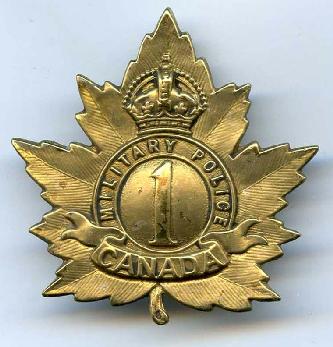
The subsequent unofficial badge produced for 1 Detachment (London-Ontario), Canadian Military Police.
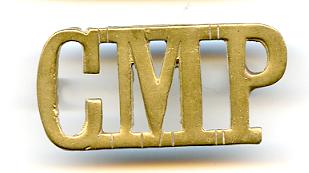 .
.
CMP Shoulder title. The Canadian version has more slender letters than the British Corps of Military Police CMP title.
The standard British version of the Military Police cap badge with GVR cypher is believed to have been worn by members of the CEF, but a distinct Canadian version was also produced, with the scroll at the base of the badge reflecting its Canadian origins.The badge was similar to the British design, but had the wreath composed of Maple leaves, rather than Laurel with the cipher "GVR" in the centre.

Note the use of Maple leaves in the wreath of the Canadian Military Police cap badge.
In 1918, the Canadian Military Police Corps was formed and the cap badge worn was altered to remove the Royal cipher from the centre, this being replaced with the letters "CMP".

Cap Badge of the Canadian Military Police Corps.
The Corps was disbanded in 1920 with many of its members absorbed into the Royal North West Mounted Police, which eventually evolved into the Royal Canadian Mounted Police.
Insignia consisting of the letters "CMPC" was also introduced, but although appearing at first glance to be a shoulder title, this was actually a collar badge, the regular shoulder title "Canada" being worn by the Military Police. The existence of Collar Dog sized versions of the Cap badge however suggests that these CMPC collar badges may have been replaced at some point, or the Collar Dog versions of the badge may have been unofficial.
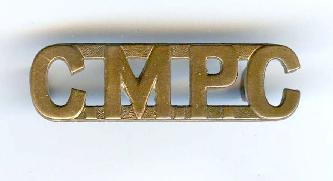
Canadian Military Police Corps Collar Badge
On the outbreak of World War Two, the military police was reformed with the first units being supplied with manpower by the Royal Canadian Mounted Police. This was No 1 Provost Company RCMP. Thus the first MP badges to be worn during World War Two were actually the original badges and shoulder titles of the RCMP.
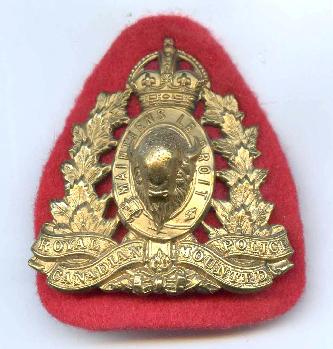
The Royal Canadian Mounted Police Badge of WW2 vintage as worn by No 1 Provost Company.
The Canadian Provost Corps was formed in 1940, absorbing the previously existing ex RCMP personnel with more Companies soon being formed. The new badge consisted of a KIngs Crown surmounted by a Lion all over a Scroll with the legend "Canadian Provost Corps"
Canadian Provost Corps Badge with Kings Crown
Post War cloth embroidered shoulder title worn with the Kings Crown version of the Canadian Provost Corps Badge.

Wartime cloth embroidered shoulder title
In 1953, with the change of Monarch, the badge was modified to represent the Queens Crown.

Post 1953 version of the Badge shown with the matching Collar Dog.
A gilt brass "C-PRO-C" shoulder title was worn.

C-PRO-C Shoulder Title
In 1968 the Canadian Armed forces - Army, Navy and Airforce were all unified under a sinmgle command structure as the Canadian Forces and the provost function renamed as the Canadian Forces Military Police Branch. A new badge was created depicting a an oval white field surrounded by a wreath of gilt Maple with an enamelled Queens Crown at the top and a scroll bearing the word "Securitas" at the base. In the centre is a "Thunderbird" emblem in multi-coloured enamels. The same Thunderbird emblem is worn as a collar dog.Shoulder titles "MP" and "PM" are worn to reflect both English and French speakers.
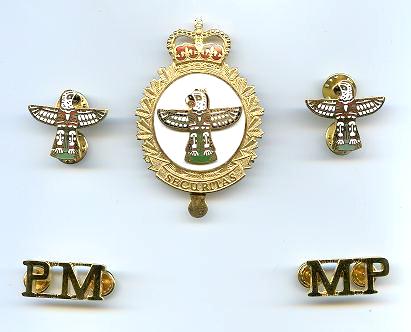
India
India’s Military Police trace their origins back to 1939 when two Provost sections were created (one Indian, one British) to serve with 4 Indian Infantry Division. These MPs served with distinction in the campaign in North Africa and in 1942, the Corps of Military Police (India) was formed.The badge worn was very similar to the British version, but in place of the Royal cipher GVIR, the Imperial cipher GRI was featured with at its base a small scroll with the word “India”.
Typical cast examples of the Indian Military Police Badge in white metal and brass.
More often than not, those examples which are encountered are locally made pieces made in cast brass rather than the finely detailed die stamped appearance of British made badges.

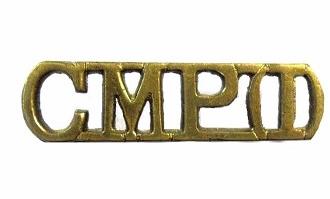
Shoulder titles for Corps of MIlitary Police (India) woven slip on and brass.
Following independence from Britain in 1947, the corps changed its name to the simpler “Corps of Military Police”.
The badge of course now lost its crown, and the Imperial cipher was replaced by a five pointed star. A small scroll at the base of this star carried the legend “Savdhan”, though later versions of the badge omit this small scroll.
Post-Independance Indian Military Police Cap Badge.
Malaysia
Malaysia’s first provost units were formed during the Malayan Emergency in 1950 as the Malay Regiment Military Police which was eventually taken under British administration in 1953.
In 1957, it was renamed as the Federation Military Police and with the creation of Malaysia became the Malaysian Military Police Corps.its Malaysian title being “Kor Polis Tentera Di Raja”.Its badge clearly shows its British origins, being of the same basic shape and format as the RMP badge, At the top is the Malaysian star and crescent with in the centre crossed blades. Surrounding this is a circular border with the legend “Polis Tentera”.
Malaysian Military Police Badge
Again,
in the British tradition, the collar dog features the same design as the cap
badge, but smaller.
New Zealand
The New Zealand Military Police were formed in 1915 and served through World War One until in 1918, being disbanded like their Australian cousins.
MPs serving on the home front wore, in the early British style, shoulder titles as cap badges before eventually changing to the cap badge described below. An “MP” armband was also worn.
The standard NZ "Onwards" Badge of the NZ Expeditionary Force.
It is believed that MPs serving overseas with the New Zealand Expeditionary Force wore the regular NZEF badge and were distinguished as MPs by the wear of a blue puggaree band on the traditional New Zealand “Lemon Squeezer” hat. MP armbands were also worn. They were reformed again in 1939 and served with distinction during World War two, being disbanded once again in 1946.
Once again, MPs serving overseas in World War Two tended not to wear the MP badge but the badge of the units they were seconded from, or the so-called “NZ-Onwards” and were principally identified by the wear of the armband.
New Zealand Military Police Cap Badge with Collar Dog
From 1915 though to 1953, the badge of the NZMP consisted of a circular field with the letters “MP” in the centre bound by a circular buckled border with the legend “New Zealand Military Police”. The whole was topped by the Kings Crown.
At the base was a scroll bearing the letters “NZ” on the left and “MP” on the right. The collar badge was identical but without the “NZMP” scroll at the base.
Regulation NZMP Shoulder Title.
Curved Shoulder Title altered from its original NZMR form.
Brass shoulder titles “NZMP” were worn with this badge and are known in two forms. The regulation type has the letters in a straight line, but due to shortages, curved “NZMR” (New Zealand Mounted Rifles) titles were often amended by having the “leg” cut off the letter “R” to alter it to a “P”.
In 1949, the title was changed to New Zealand Provost Corps.
With the change of Monarch in 1953 and the grant of the “Royal” prefix a new badge was introduced styled closely on the British badge. It featured the “EIIR” cypher in the centre of a circular wreath of laurel with the Queens Crown above. The scroll at the base of the wreath carried the legend “Royal NZ Provost”.
The badge was made in Anodised aluminium from 1960 and a smaller but identical version worn as a collar dog.
Very early Royal NZ Provost Cap Badge in brass.
Royal NZ Provost Cap Badge in anodised aluminium.
In the 1980s, the Corps was once again renamed, becoming the Royal New Zealand Military Police. The new badge returned to the original 1915 design concept but was contained within a wreath. The badge is silvered and has the centre field and the background to the scrolls painted blue.
The collar dog has a similar design but lacking the surrounding wreath.
Current RoyalNew Zealand Military Police Cap Badge
Rhodesia
The Southern Rhodesia Corps of Military Police was formed in 1963 shortly before the declaration of independence (UDI).
At that time the badge was broadly similar to that used by Britain but with a Lion Couchant over a scroll bearing the legend “Rhodesia” replacing the EIIR cipher.
First Type Rhodesian Military Police Cap Badge.
Post independence, the Crown was replaced by a Bird of Prey perched upon a drum.
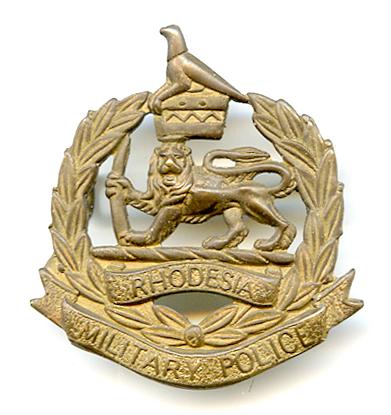
Post Independance Rhodesian Military Police Cap Badge
Finally, the Lion in the centre was replaced by the letters “MP” and the Scroll lettering from “Rhodesia” to “Zimbabwe” whilst the “Military Police” lettering in the scroll at the base of the badge was altered to the motto “Exemplo Ducemus”.
Zimbabwe Military Police Cap Badge with Collar Dog.
A Shoulder title RhMP was worn.
RhMP Shoulder Title
It is believed that the present day Zimbabwean Military Police wear a general service cap badge identical to other army units, and are identified as MPs by the use of the bright red Beret.
South Africa
The first formal military police formation in South Africa was the South African Mounted Rifles (SAMR) created in 1913 by the amalgamation of four existing units, the Cape Mounted Police, the Cape Mounted Rifles, the Transvaal Police and the Natal Police. The SAMR was to provide the military branch of the constabulary.Somewhat confusingly, although the SAMR was termed the military branch of the Constabulary, in 1916 within its ranks was created a small detachment designated as Military Police based at Robert’s Heights. This unit may have been a broad equivalent to Britain’s MPSC (Military Provost Staff Corps) as its OC was also designated as Superintendant of Detention Barracks.Within 4 Regiment, SAMR, from 1914 to 1918, there were two companies of Military Police who wore shoulder titles 1MP or 2MP in conjunction with the regular SAMR cap badge.
Cap Badge of the South African Mounted Rifles
The bulk of the SAMR was disbanded in 1922 at which point responsibility for provost type duties was taken over by the South African Field Artillery which carried out these tasks until 1938. Those carrying out provost duties were identified by an armband and a police pattern leather belt and cross strap.
Cap Badge of the South African Field Artillery
In December 1938 the South African Corps of Military Police was formed. The cap badge for this Corps was in Brass and consisted of a hand, holding the scales of justice surrounded by a wreath of laurel and at the base a scroll bearing at left the letters SACMP and at right SAMPK. A smaller version of the same badge was used as a collar dog. Examples exist with either a solid field or voided and the badges may be found in die stamped or more crudely cast versions.
First Type SACMP/SAMPK Cap Badge. Die struck non-voided type.
A shoulder title bearing the two designations SACMP / SAMPK in curved format was worn, attached to the shoulder strap via an orange cloth slide.
SACMP/SAMPK Shoulder Title
A new badge was introduced for the Corps in 1957 with the hand holding the scales of justice replaced by the Sword of Gideon.
First type Sword of Gideon badge in gilt metal with Collar Dog.
This badge was originally in Brass but in 1977 was changed to a chrome plated finish.
Chromed version of the Sword of Gideon Badge with Collar Dog.
From 1984 to 1999 individual unit badges were produced which featured a small enamelled insignia superimposed on the blade of the Sword. Subsequent to this the previous design was reverted to.